Introduction to Difference between BST and Binary Tree
Diverse data structures in computer science aid in the organization of data in various formats. Trees like Bst and binary tree are a common abstract data format that simulates a hierarchical tree structure among them. A tree typically contains a root value and subtrees built by child nodes of its parent nodes. Data structures in the form of trees and the difference between Bst and Binary tree. The number of child nodes that may be held by a standard tree data structure is the main difference between Bst and binary tree.
However, in the difference between Bst and Binary tree, this is not the case. A Binary Search Tree, or BST, is a tree that is used for sorting, retrieving, and searching data, as the name implies. It’s also a non-linear data structure where the nodes are organized in a certain order. As a result, it’s also known as an “Ordered Binary Tree.”
What is a Tree?
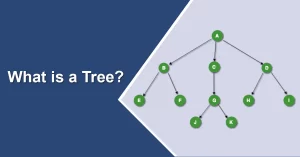
Here in the difference between Bst and Binary Tree, a tree-like Bst and the binary tree is a type of data structure used to represent data in a hierarchical format. It may be defined as a collection of nodes (objects or entities) that are connected together to create the stimulation of a hierarchy. The data in a tree is not stored linearly or sequentially, making it a non-linear data structure. Examples of trees include the difference between Bst and binary tree.
What is a Binary Tree?
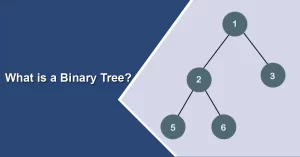
In the difference between Bst and Binary tree, a binary tree is a non-linear data structure of the tree type with a maximum of two children per parent. Along with the data element, each node in a binary tree has a left and right reference. The root node is the node at the very top of a tree’s structure. The parent nodes are the nodes that include additional sub-nodes.
The left child and right child are the two child nodes of a parent node. A binary tree is used in a variety of applications, including hashing, routing data for network traffic, constructing binary heaps, and binary search trees. One of the most basic data structures is the tree. They’re employed to organize and store data. A binary tree is a tree data structure made up of nodes (left and right nodes), each of which has at most 2 children. The tree begins with a single node, which is referred to as the root. In the instance of a leaf node, the left and right child pointers are null. The following information is contained in each node of the tree:
- Data
- Pointer to the left child
- Pointer to the right child
Properties of Binary Tree
In the difference between Bst and Binary tree, now let’s look at properties, although Bst and binary tree are much alike there are some differences in properties:
- The maximum number of nodes at each level of i is 2i.
- The longest path from the root node to the leaf node determines the tree’s height.
- Suppose a tree stands at a height of 3.
- As a result, at height 3, the maximum number of nodes is (1+2+4+8) = 15.
- In general, for height h, the maximum number of nodes is (20 + 21 + 22+….2h) = 2h+1 -1.
- At height h, the smallest number of feasible nodes is h+1.
- If the number of nodes is the smallest, the tree’s height will be the greatest.
- In contrast, if the number of nodes is greatest, the tree’s height is the smallest.
If the binary tree has a certain number of nodes ‘n’ then:
The min height can be assessed as:
As we know that,
n = 2h+1 -1
n+1 = 2h+1
Taking log on both the sides,
log2(n+1) = log2(2h+1)
log2(n+1) = h+1
h = log2(n+1) – 1
The max height can be evaluated as:
As we know,
n = h+1
h= n-1
Common Terminologies of Binary Tree
In the difference between Bst and Binary tree, there are certain terminologies in the difference between Bst and binary tree. Let’s have a glance:
- Root: Topmost node in the tree is referenced to be the root.
- Parent: Every node in a tree (excluding the root) is connected to exactly one other node via a directed edge.
- Child: When going away from the root, a child is a node that is directly related to another node.
- Leaf or External Node: Node with no children is called leaf or external node
- Internal Node: Node having at least one child is referred to as an internal node.
- Depth of a Node: The depth of a node is the no. of edges from the root to the node.
- Height of a Node: No. of edges from the node to the deepest leaf. This determines the height of a node. The root’s height is the tree’s height.
Common Operations
There are some common operations in the difference between Bst and binary tree. The operations that may be done on a binary tree are listed below:
Insertion
In a binary tree, elements can be placed in any sequence. The root node is created with the initial insertion operation. Each subsequent insertion repeatedly searches each level of the tree for an empty place. The new element is introduced when an empty left or right child is found. The insertion is always started from the left child node by tradition. This operation is available in both Bst and binary trees, also it is not a difference between Bst and Binary tree.
Deletion
It is also possible to delete an element from the binary tree. Because the elements are not in any specific order, when a node is deleted, it is replaced with the right-most element. One of the most efficient and widely used data structures are binary trees. They are used to illustrate hierarchies and express structural relationships in data. This operation is available in both Bst and binary trees, also it is not a difference between Bst and Binary tree.
Tree traversal
Traversal is another commonly used tree operation. The procedure of traversing each node in a tree is known as tree traversal. This operation is available in both Bst and binary trees, also it is not a difference between Bst and Binary tree. There are 3 ways to traverse a tree:
- In-order traversal
- Pre-order traversal
- Post-order traversal
Types of Binary Tree
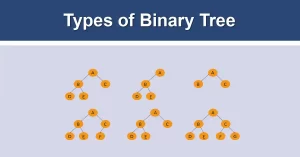
There are many different forms of and difference between Bst and binary tree, each with its own set of properties. Each of the binary tree
variants is described in depth below.
Full or Proper or Strict Binary Tree
A strict binary tree is another name for a full binary tree. If each node has either 0 or 2 offspring, the tree can only be termed a complete binary tree. Except for the leaf nodes, the full binary tree may alternatively be described as a tree in which each node must have two children. In the difference between Bst and binary tree, this is a type of binary tree.
It’s a specific type of binary tree that contains either zero or two children. It indicates that every node in the binary tree should contain two child nodes, or the parent node should be the leaf node or the external node itself. In other terms, a full binary tree is a distinct binary tree in which every node has two children except the exterior node. This is an important difference between Bst and Binary Tree.
Quite a binary tree would not be a full binary tree if it just has one child. The number of leaf nodes equals the number of internal nodes plus one in this case. L=I+1, where L is the multitude of leaf nodes and I is the number of internal nodes, is the equation.
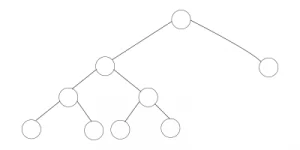
Properties of Full Binary Tree:
- The number of leaf nodes equals the no. of internal nodes plus one. The no. of internal nodes in the above example is 5, hence the number of leaf nodes is 6.
- The greatest number of nodes is the same as a binary tree’s number of nodes i.e., 2h+1 -1.
- The min no. of nodes in a full binary tree = 2*h-1.
- log2(n+1) – 1 is the min-height of the full binary tree.
- The max height of the full binary tree could be evaluated as:
n= 2*h – 1
n+1 = 2*h
h = n+1/2
Complete Binary Tree
A complete binary tree is a sort of binary tree in which all of the tree’s levels, save the lowest, are completely filled with nodes. Except for the last level, the complete binary tree is a tree in which all of the nodes are entirely filled. All of the nodes in the final level must be as far to the left as feasible. The nodes of a complete binary tree should be inserted from the left. In addition, every node in the binary tree’s final or lowest level should be on the left side. The difference between Bst and binary tree it is a type of binary tree. Here is a structure of the complete binary tree:

Properties of Complete Binary Tree:
- Max No. of nodes of a complete binary tree is equal to 2h+1 – 1.
- Min No. of nodes of a complete binary tree is equal to 2h.
- Min height of the complete binary tree is equal to log2(n+1) – 1.
A complete binary tree is similar to a full binary tree, but there are some significant distinctions.
- Every level must be completed in its entirety.
- The leaf components must all slant to the left.
- A complete binary tree does not have to be a full binary tree because the last leaf element may not have the right sibling.
Perfect Binary Tree
If all internal nodes have exactly two children and every exterior or leaf node is at the exact level of depth inside the tree, it is said to be ‘perfect.’ 2h – 1 node is there is a perfect binary tree of height ‘h‘. In the difference between Bst and binary tree, this is a type of binary tree.
- In a perfect binary tree with l leaves. There are n = 2l-1 nodes.
- l = 2h and n = 2h+1 – 1 in a perfect full binary tree, where n is the number of nodes, h is the tree’s height, and l is the number of leaf nodes.

Balanced Binary Tree
When the height of a binary tree is O(logN), where ‘N’ is the number of nodes, the tree is said to be ‘balanced.’ The height of each node’s left and right subtrees should differ by no more than one in a balanced binary tree. A balanced binary search tree can be generated using a data structure like an AVL Tree or a Red-Black Tree. It’s a sort of binary tree in which each node’s height difference between the left and right subtrees is either 0 or 1. An empty tree is height-balanced. In the difference between Bst and binary tree, this is a type of binary tree.
If a binary tree fulfills these conditions, it is height-balanced:
- The heights of the right and left subtrees differ by no more than 1.
- The left subtree is balanced
- The right subtree is balanced
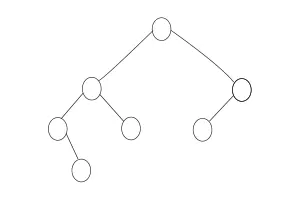
Degenerate Binary Tree
If every internal node has just one child, the binary tree is considered to be a degenerate binary tree or pathological binary tree. In terms of performance, such trees are equivalent to linked lists. In the difference between Bst and binary tree, this is a type of binary tree.
Let’s look at a few samples of the Degenerate binary tree.
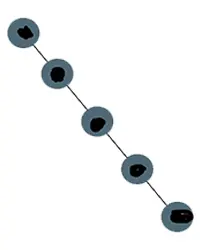
Because all of the nodes in the above tree have just one child, it is a degenerate binary tree. It’s also known as a right-skewed tree since each node only has one right child. In the difference between Bst and binary tree, this is a type of binary tree.
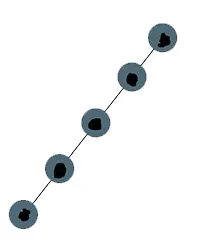
Because all of the nodes have only one child, the above tree is also a degenerate binary tree. It’s also known as a left-skewed tree since every node has just a left child. In the difference between Bst and binary tree, this is a type of binary tree.
Benefits of a Binary Tree
In the difference between Bst and Binary tree, trees like Bst and binary tree are very beneficial and widely used because they provide a number of significant benefits:
- The structural linkages in the data are shown in trees.
- Hierarchies are represented by trees.
- Insertion and searching are made easier using trees.
- Trees are an extremely versatile kind of data because they enable you to shift subtrees around with little effort.
- When compared to other trees, the search process in a binary tree is faster.
- To get the elements in sorted order, just two traversals are required.
- Picking up the maximum and lowe
st components is simple. - Binary trees are employed in graph traversal.
- Binary trees can be used to convert various postfix and prefix expressions.
Binary Tree Implementation
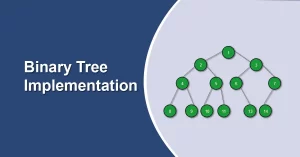
In the difference between Bst and Binary tree, with the use of pointers, a binary tree is created. BST and binary tree are implemented through a set process. The root pointer represents the tree’s very first node. The tree’s nodes are made up of three parts: data, left pointer, and right pointer. We must first build the node in order to generate a binary tree. As demonstrated below, we’ll construct a user-defined node:
struct node
{
int data,
struct node *left, *right;
}
Data is the value in the aforementioned structure, while the left pointer holds the address of the left node and the right pointer holds the address of the right node.
Binary Tree program in C
#include
struct node
{
int data;
struct node *left, *right;
}
void main()
{
struct node *root;
root = create();
}
struct node *create()
{
struct node *temp;
int data;
temp = (struct node *)malloc(sizeof(struct node));
printf(“Press 0 to exit”);
printf(“nPress 1 for new node”);
printf(“Enter your choice : “);
scanf(“%d”, &choice);
if(choice==0)
{
return 0;
}
else
{
printf(“Enter the data:”);
scanf(“%d”, &data);
temp->data = data;
printf(“Enter the left child of %d”, data);
temp->left = create();
printf(“Enter the right child of %d”, data);
temp->right = create();
return temp;
}
}
What is a Binary Search Tree?
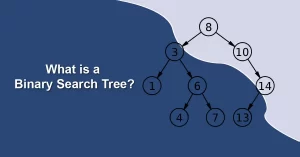
The BST and binary tree are much alike although Bst is a sophisticated technique for examining nodes, their left and right branches, which are represented in a tree structure, and returning a result. Because the binary search tree is built on the architecture of a fundamental binary search algorithm, it allows for quicker node lookups, insertions, and deletions. As a result, the software is extremely quick and precise.
In Bst and binary tree, a Binary Search Tree is a binary tree with a key and an optional associated value at each node. It enables extremely quick item lookup, adding, and removal. The nodes in a binary search tree are ordered as per the following properties:
- A node’s left subtree will always contain nodes with keys that are less than that node’s key.
- Nodes with keys bigger than a node’s key will always be found in the right subtree of that node.
- Binary search trees will be found in both the left and right subtrees of each node.
As a result, BST and binary tree are distinct as BST separates all of its sub-trees into two segments: the left and right subtrees, and may be characterized as:
left_subtree (keys) < node (key) ≤ right_subtree (keys)
1. Time Complexity
The following qualities, in most situations, allow insert, search, and delete operations to be performed in O(logn)O(log n)O(logn) time, where n is the number of nodes in the tree. In the worst scenario, when the tree becomes imbalanced, the time complexity of these operations is O(n)O(n)O(n).
|
Operations |
Best case time complexity |
Average case time complexity |
Worst-case time complexity |
|
Insertion |
O(log n) |
O(log n) |
O(n) |
|
Deletion |
O(log n) |
O(log n) |
O(n) |
|
Search |
O(log n) |
O(log n) |
O(n) |
2. Space Complexity
In both the average and worst instances, the space complexity of a binary search tree is O(n)O(n)O(n).
|
Operations |
Space complexity |
|
Insertion |
O(n) |
|
Deletion |
O(n) |
|
Search |
O(n) |
3. Types of Traversals
This is a common operation in Bst and Binary Tree. The Binary Search Tree can be navigated in a variety of ways:
- Pre-order Traversal: Pre-order traversal visits nodes in the order Parent-LeftChild-RightChild.
- In-order Traversal: In-order traversal visits nodes in the order LeftChild-Parent-RightChild. The tree is visited in ascending order of keys in this manner.
- Post-order Traversal: The traversal will traverse nodes in the order LeftChild-RightChild-Parent.
Why do we need a Binary Search Tree?
In the difference between Bst and Binary tree, let’s look at what is the need for a binary search tree.
- Speed and Accuracy are the two primary elements that make binary search trees the best solution for any real-world situation.
- Because the binary search is in a branch-like pattern with parent-child relationships, the algorithm understands where the items need to be searched in the tree. This reduces the amount of key-value comparisons the software must perform in order to find the target element.
- In addition, the node understands which tree side to look for if the element to be sought is more or less than the parent node. The reason for this is that the left sub-values trees are always fewer than the parent nodes, while the right sub-values trees are always equal to or larger.
- Complex searches, strong game logic, auto-complete activities, and visuals are all frequent uses for binary search trees.
- Search, insert and remove actions are all supported by the algorithm.
Representation of the difference between Bst and Binary Tree
In the difference between Bst and Binary tree, as BST is a set of nodes structured in such a manner that they all have the same BST attributes. A key & a value are allocated to each node. The required key is compared to the keys in BST during the search, and if found, the related value is obtained.
A visual illustration of BST is shown below.
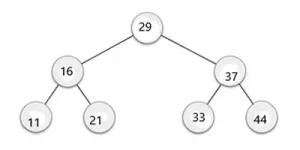
The root node key (29) has all lower-valued keys on the left sub-tree and higher-valued keys on the right subtree, as can be seen.
Basic Operations
The basic operations of a tree-like Bst and binary tree are as follows:
- Search: Searches for a certain element in a tree.
- Insert: Inserts
a new element into a tree. - Pre-order Traversal: Pre-order Traversal traverses a tree in the order in which it was created.
- In-order Traversal: In-order Traversal traverses a tree in a sequential fashion.
- Post-order traversal: Traversing a tree in a post-order way is known as post-order traversal.
Searching in Binary Search Tree
In a data structure, searching implies finding or locating a certain element or node. In BST and binary tree, the binary search tree components are kept in a specified sequence, finding a node in a Binary search tree is simple. This is a common operation in Bst and binary tree and is not a difference between Bst and Binary Tree. The stages involved in finding a node in a Binary Search tree are as follows:
- To begin, compare the element to be searched with the tree’s root element.
- Return the position of the node if the root matches the target element.
- If it isn’t matched, check whether the item is smaller than the root element; if it is, go to the left subtree.
- Move to the right subtree if it is greater than the root element.
- Recursively repeat the technique above until the match is discovered.
- Return NULL if the element isn’t discovered or doesn’t exist in the tree.
Algorithm to search in Bst and binary tree comparison
Search (root, item)
Step 1 – if (item = root → data) or (root = NULL)
return root
else if (item < root → data)
return Search(root → left, item)
else
return Search(root → right, item)
END if
Step 2 – END
Insertion in Binary Search Tree
The difference between BST and binary tree, in Bst a new key is always introduced at the leaf. To insert an element in BST, start at the root node and search for an empty spot in the left subtree of the node to be added is smaller than the root node. Otherwise, look for an empty spot in the correct subtree and fill it in. In BST, inserting is similar to searching in that we must constantly remember that the left subtree is lesser than the root and the right subtree is larger. Insertion operation is present in both Bst and binary tree and is not a difference between Bst and Binary Tree.
Algorithm for Insertion in Binary Search Tree: BST and Binary Tree distinction
void insert(int data) {
struct node *tempNode = (struct node*) malloc(sizeof(struct node));
struct node *current;
struct node *parent;
tempNode->data = data;
tempNode->leftChild = NULL;
tempNode->rightChild = NULL;
//if tree is empty
if(root == NULL) {
root = tempNode;
} else {
current = root;
parent = NULL;
while(1) {
parent = current;
//go to left of the tree
if(data < parent->data) {
current = current->leftChild;
//insert to the left
if(current == NULL) {
parent->leftChild = tempNode;
return;
}
} //go to right of the tree
else {
current = current->rightChild;
//insert to the right
if(current == NULL) {
parent->rightChild = tempNode;
return;
}
}
}
}
}
Deletion in Binary Search Tree: BST and Binary Tree distinction
In the difference between Bst and Binary Tree, there are several scenarios for removing a node from a BST and binary tree, such as deleting a root or deleting a leaf node. We must also consider the root node after removing a root. If we wish to delete a leaf node, we may simply delete it; however, we must replace the root’s value with another node if we want to delete a root. Deletion operation is present in both Bst and binary tree and it is not a difference between Bst and Binary Tree. Consider the following scenario:
- Case A = Node with zero children: this is the simplest circumstance; all you have to do is remove the node on the right or left that has no more children. This was Case A difference between Bst and binary tree deletion operation.
- Case B = Single-child node: after deleting the node, just connect its child node to the removed value’s parent node. This was the Case B difference between Bst and binary tree deletion operation.
- The most challenging circumstance is Case C Node with two children, which is based on the following two principles.
- C1 – In Order Predecessor: Delete the node with two children and replace it with the highest value on the destroyed node’s left-subtree. This was the Case C1 difference between Bst and binary tree deletion operation.
- C2 – In Order Successor: Delete the node with two children and replace it with the highest value on the destroyed node’s right-subtree. This was the Case C2 difference between Bst and binary tree deletion operation.
Implementation of Binary Search Tree
Let’s look at the software that implements the Binary Search tree operations and look at this difference between Bst and binary tree. The activities of a binary search tree will be implemented in this application. The construction, in order traversal, insertion, and deletion actions of a tree will be demonstrated here and the difference between Bst and Binary Tree.
Here, we’ll look at an inorder tree traversal to determine if the tree’s nodes are in the right place. We already know that in order traversal always returns results in ascending order. So, after executing the insertion and deletion operations, we execute the inorder traversal, and if we have data in ascending order after traversing, we know the nodes are in the correct position. Now let us look at the implementation difference between BST and Binary Tree.
What is the difference between BST and Binary Tree?
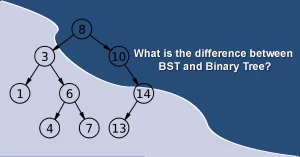
|
Parameter |
Binary Tree |
Binary Search Tree |
|
Definition |
A Binary Tree is a non-linear data structure with nodes that can have two, one, or zero nodes. Each node is made up of a right pointer, a left pointer, and a data element. |
The BST, or Binary Search Tree, is an ordered Binary Tree with structurally arranged nodes. Each subtree must be a component of the structure in question. |
|
Operations Performance |
The Binary Tree may be used to accomplish operations such as insertion, deletion, and traversal. |
As the Binary Trees are sorted, they may be used for efficient and quick binary search, deletion, and insertion. |
|
Structure |
It does not need a well-organized structure of the nodes in a tree. |
It has a well-defined structure. The right subtree’s |
|
Types |
There are various forms of binary trees. The Full Binary Tree, Complete Binary Tree, and Extended Binary Tree are the most prevalent. |
There are several forms of Binary Search Trees. Splay Trees, AVL Trees, T-Trees, Tango Trees, and other varieties are among the most popular. |
|
Speed |
The deletion, insertion, and searching procedures are slower in the Binary tree than in the Binary Search Tree because it is unordered. |
The Binary Search Tree performs quicker deletion, insertion, and searching of items since it has ordered properties. |
|
Hierarchy |
Binary Trees are a type of hierarchical data structure. It is made up of nodes, which are a collection of elements. |
The nodes are placed in relative order in this Binary Tree version. |
|
Time Taken |
When compared to a Binary Search Tree, any operation on a Binary Tree takes longer. As a result, inserting, searching, and deleting data takes O(n) time. |
A Binary Search Tree maintains its sorting. As a result, insert, search, and delete operations are quicker. Thus, it takes about O(log n) time to complete. In the event of lookups, a user can primarily use the BST (because all the keys stay arranged in sorted order). |
|
Duplicate Values |
Duplicate node values are allowed in the Binary Tree. |
Duplicate node values are not allowed in the Binary Search Tree. |
|
Usage |
In any tree structure, the Binary Tree works well for efficient and rapid lookup of information and data. |
When it comes to element deletion, insertion, and searching, the Binary Search Tree excels. |
So now you must be well familiar with the difference between BST and Binary Tree.
Conclusion
So guys we learned about the difference between BST and Binary Tree in this blog. Although both the Binary Tree and the Binary Search Tree have a hierarchical structure with a collection of nodes, they are used in different ways. A Binary Tree is a basic structure with the simple restriction that no parent can have more than two offspring, but a Binary Search Tree is a version of the binary tree that organizes the nodes in a certain order.
Frequently Asked Question’s
1. What is difference between B tree and binary tree?
As its nodes are ordered in inorder traversal, the B-tree is known as a self-balancing tree. In B-tree, unlike a binary tree, a node can have more than two children. This is a difference between Bst and binary tree.
2. Are BST and binary tree same?
A Binary Search Tree (BST) is a kind of Binary Tree data structure in which each node has a similar value and lesser valued children are linked to the left and higher valued children to the right.
As a result, all BSTs are Binary Trees, but only some Binary Trees are also BSTs. So now you know about the difference between Bst and binary tree.
3. What is the difference between binary tree and binary heap?
We learned about the difference between Bst and binary tree. Now let’s learn about the difference between binary tree and binary heap. Well, the main difference is that the Binary Search Tree does not permit duplicates, but the Heap can. The BST has been ordered, but Heap has not. So, if you value order, BST is the approach to go for after knowing the difference between Bst and binary tree.
4. What is the difference between BST and AVL tree?
There is no such thing as a balancing component in BST. Each node in the AVL tree has a balancing factor, which must be one of the following values: -1, 0, or 1. Because BST can be either balanced or unbalanced, not every Binary Search tree is an AVL tree this is a key difference between Bst and binary tree.
5. Are B-trees of Order 2 full binary trees?
According to Horowitz’s the difference between Bst and binary tree is the Fundamentals of Data Structure in C++, a B tree of order 2 must certainly be a full tree. However, any tree of order 2 (with one or two children) cannot be a B tree; only those with 2k nodes may create a B tree of order 2.
A B+ tree is a multi-node m-ary tree with a variable, but frequently large, number of children per node. A root, internal nodes, and leaves make up a B+ tree. A leaf or a node with 2 or more children might be the root. Extent trees (a modified B+ tree data structure) are used by EXT4 to index file extents and is the main difference between Bst and binary tree.
The AVL tree is the self-balancing BST. That is with the max height difference between the left and right subtrees of 1 for all nodes. Because the height differences between the left and right subtrees for each node are less than or equal to 1, the tree is AVL and is the main difference between Bst and binary tree.
8. What is binary tree example?
A BST and Binary Tree has several examples. A perfect binary tree is one in which every inner node has two children and every leaf has the same depth or level and is the main difference between Bst and binary tree. The (non-incestuous) lineage chart of a person to a particular depth is an example of a perfect binary tree, as each individual has precisely two biological parents (one mother and one father).
9. Which is better BST or heap?
Binary heaps can be built on top of dynamic arrays or pointer-based trees, although BST only supports pointer-based trees. If we can tolerate periodic resizing latencies, we may use the more space-effective array implementation for the heap. For BST, the generation of a binary heap takes O(n) in the worst case and O(n log(n) in the best scenario and is the main difference between Bst and binary tree.
10. Can a binary tree be full and complete?
Every binary tree is either full or complete. A full binary tree is the same as a complete binary tree. Each of the complete binary trees is a full binary tree. There is no binary tree that is both full and complete. This is a difference between Bst and binary tree.













